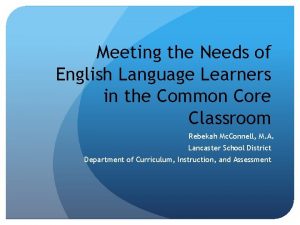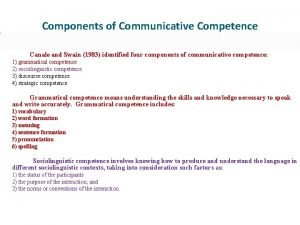Communicative Competence Academic Language and ELD Torah Skelton

- Slides: 1

Communicative Competence, Academic Language, and ELD Torah Skelton | Western Oregon University Objective • Problem Statement: High school aged ELL students are comfortable speaking in colloquial language, but avoid using academic language in discussions. They may struggle with reaching higher levels on Costa’s Levels of Questioning. • Research Question: How can students develop academic language in an authentic and relevant manner? Methods Sample Discussion (Day 11) • Connected to Oregon ELP standards and Common Core for English Language Arts. • Incorporation of research based discussion activities found both in ELD and ELA classrooms (Zwiers and Crawford, 2011; Serravallo, 2015). • Usage of formal and informal assessments (discussion checklist, rubrics for written products (evidence collection). • The lesson uses a video as the Anticipatory Set (viewpoint 1). • Includes a news story with Gradual Release of Responsibility (viewpoint 2) as the focus of lesson. • Students use the AVID graphic organizer to compare the two viewpoints and develop their own claim in response. Overview of Curriculum Design Research Connection • Concerns have been raised that BICS and CALP are an inauthentic measure of fluency. (Auckerman, 2007; Bailey and Huang, 2011) • Some assessments used to measure fluency can be problematic, as fluency levels vary between tests. (Pray, 2005) • Discussion-based assessments must be “active and purposeful” and should directly relate to real-world situations and students’ funds of knowledge. (Leung and Lewkowicz, 2006; Mc. Cann, 2003; Johannessen, 2003) Conclusion • Meant to increase academic language, the ability to create and support a claim and to use higher-order thinking skills as applied to real-world issues and situations. • Group dynamics are largely based on personality types (introversion/extroversion), which might skew perception of students’ comprehension and fluency. • The twelve, ninety minute lessons included in this unit purposefully integrate content-area information and AVID strategies with ELD objectives. • Ambition in the first stages of development are important, but curricula can change as time progresses and the needs of students are better understood. Sample Discussion Image (Day 2) References Yang, G. L. (2006). American Born Chinese. New York, NY: First Second. • Aukerman, M. (2007). A Culpable CALP: Rethinking the Conversational/Academic Language Proficiency Distinction in Early Literacy Instruction. The Reading Teacher, 626 -635. • Bailey, A. , & Huang, B. (2011). Do current English language development/proficiency standards reflect the English needed for success in school? Language Testing, 28(3), 343 -365. • Johannessen, L. (2003). Strategies for Initiating Authentic Discussion. The English Journal, 93(1), 73 -79. • Leung, C. , & Lewkowicz, J. (2006). Expanding Horizons and Unresolved Conundrums: Language Testing and Assessment. TESOL Quarterly, 40(1), 211 -234. • Mccann, T. (2003). Imagine This: Using Scenarios to Promote Authentic Discussion. The English Journal, 92(6), 31 -39. • Oregon Department of Education (2015). Statewide Annual Report Card 2014 -2015. • Pray, L. (2010). How Well Do Commonly Used Language Instruments Measure English Oral-Language Proficiency? Bilingual Research Journal, 387 -409. • Serravallo, J. (2015). The reading strategies book: Your everything guide to developing skilled readers. Portsmouth, NH: Heinemann. . • Sousa, D. (2002). How the Brain Learns. Corwin. • Yang, G. L. (2006). American Born Chinese. New York, NY: First Second. • Zwiers, J. , & Crawford, M. (2011). Academic conversations: Classroom talk that fosters critical thinking and content understandings. Portland, Me. : Stenhouse.

